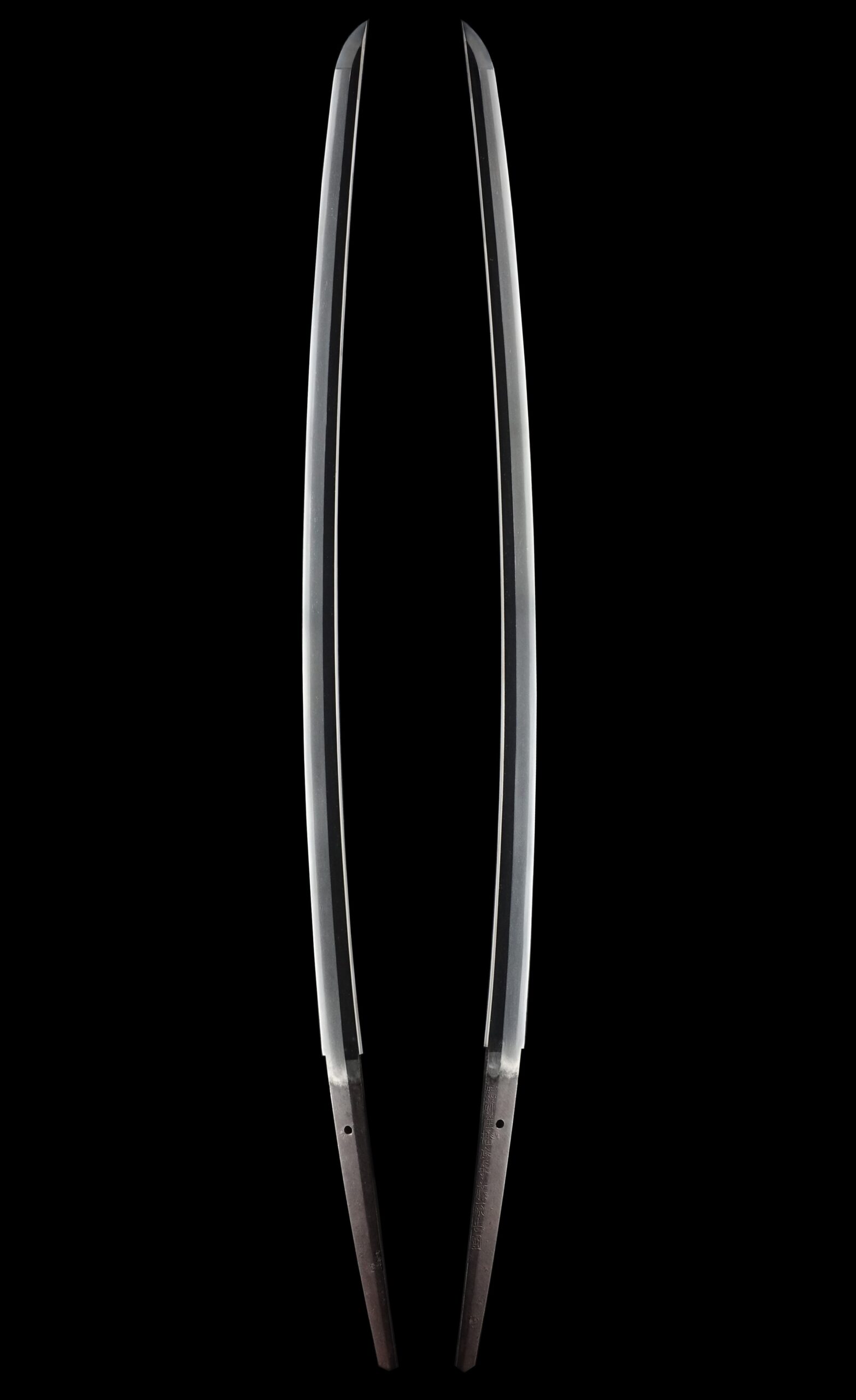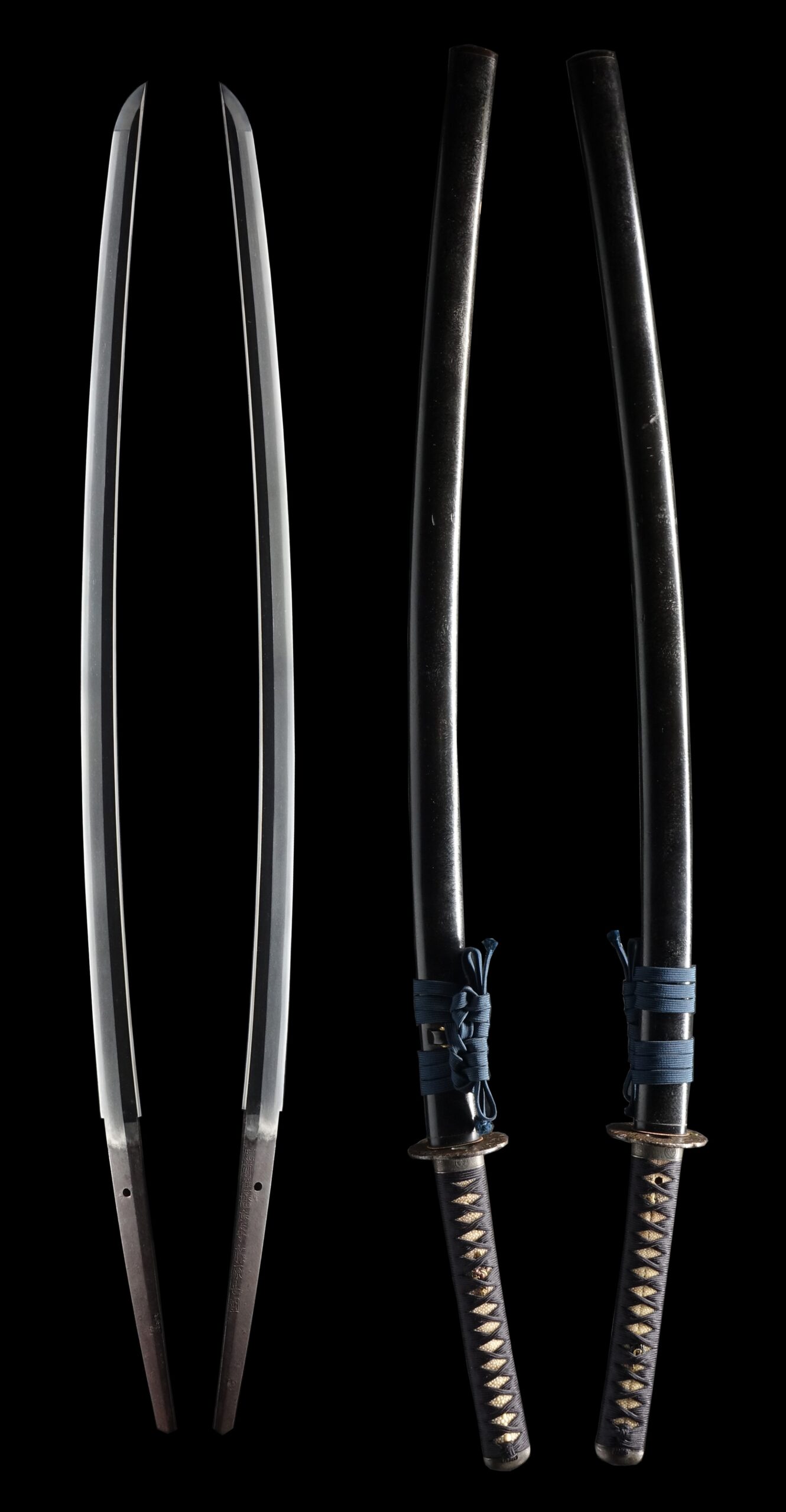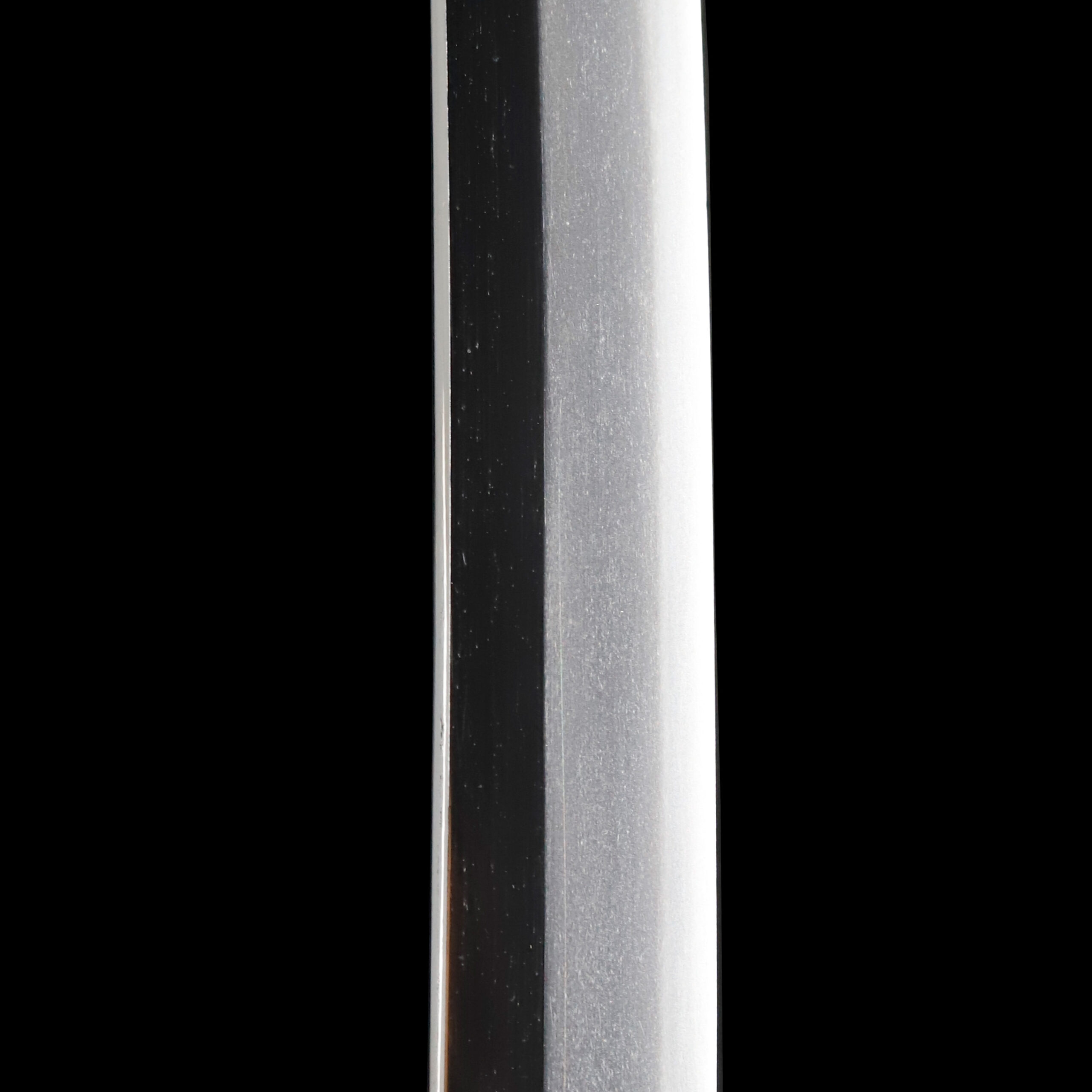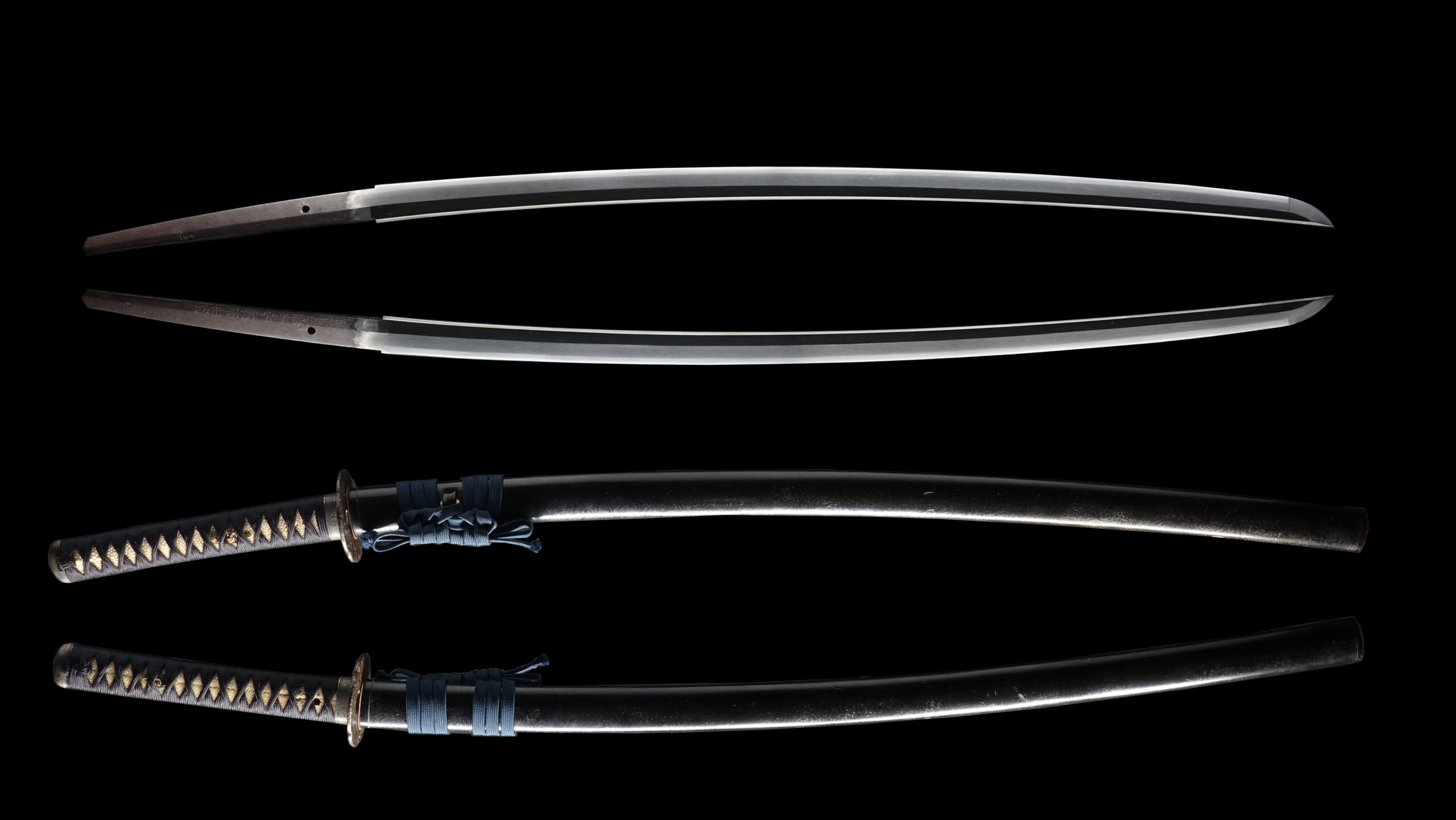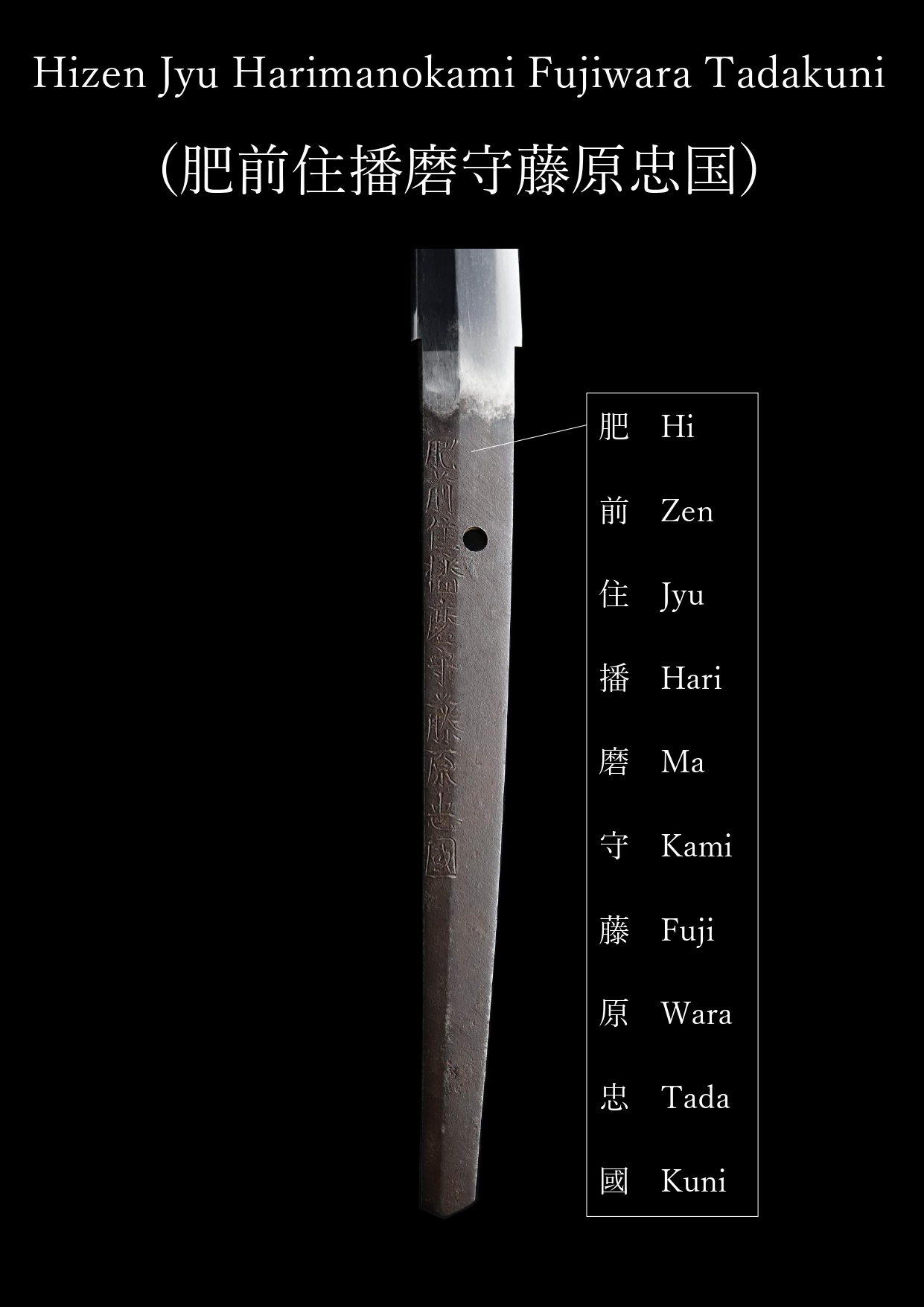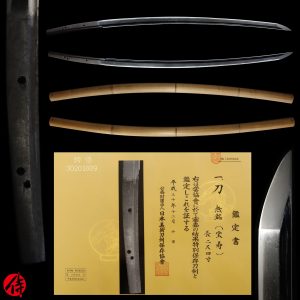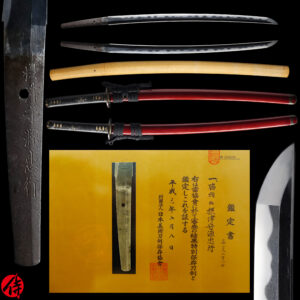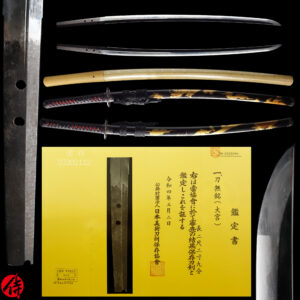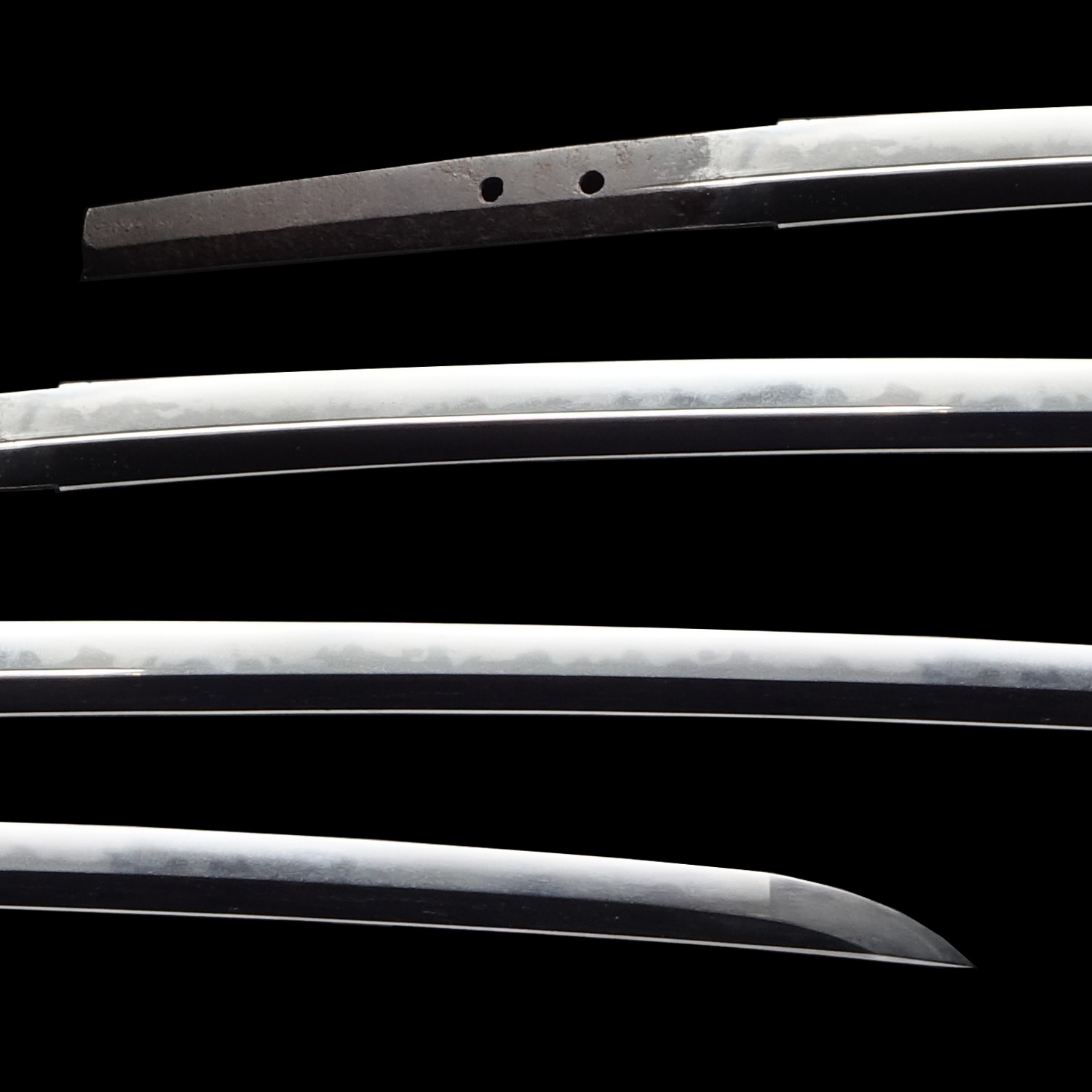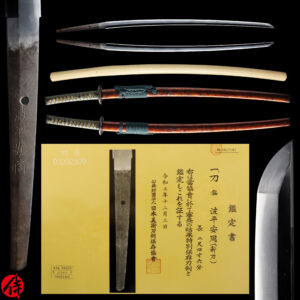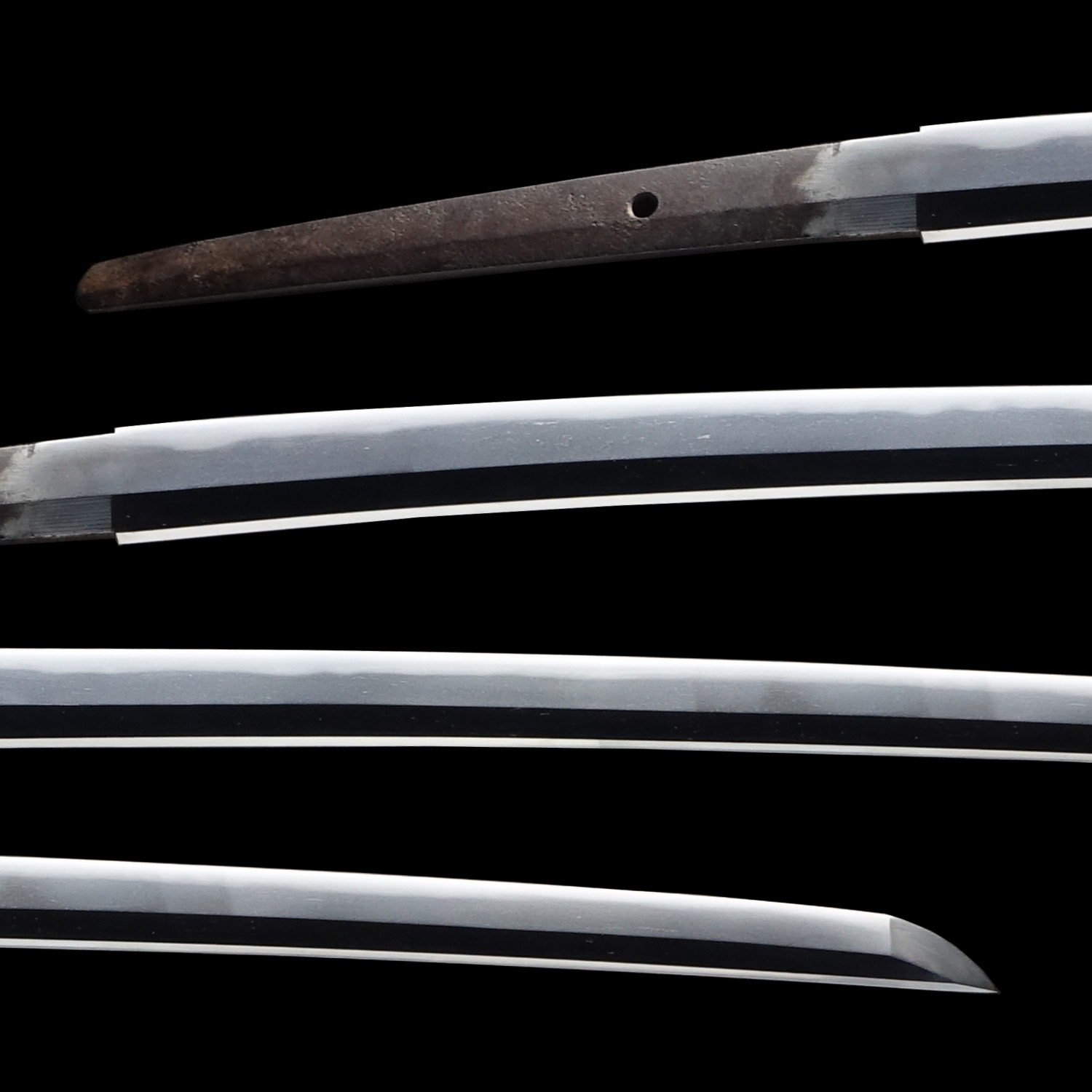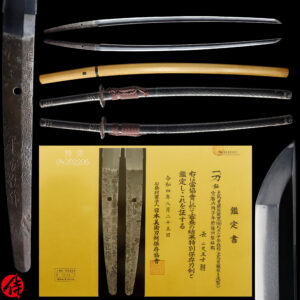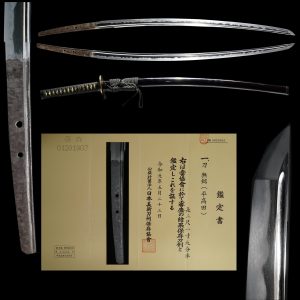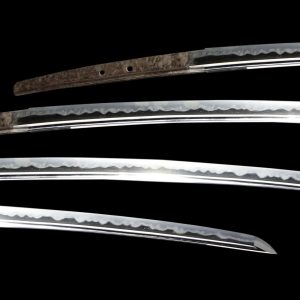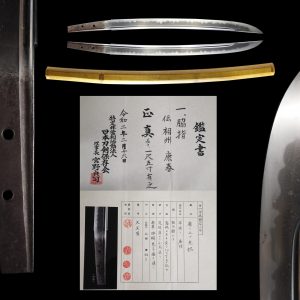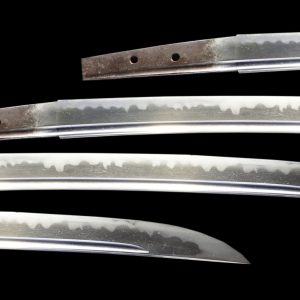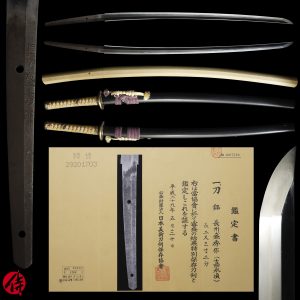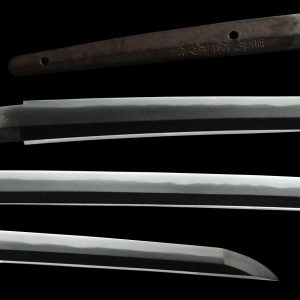Antique Japanese Sword Katana Signed by the third-gen Tadakuni with Tokubetsu Hozon Certificate
【Description】
Summary
This blade was signed by Hizen Jyu Harima no Kami Fujiwara Tadakuni (肥前住播磨守藤原忠国). The maker’s name Tadakuni lasted three generations, and according to its NBTHK’s appraisal, it was signed by the third-gen Tadakuni. The third-gen Tadakuni was the son of the second-gen Tadakuni. He was active during the Kyoho era (mid Edo period: 1716-1736). Hizen is where he forged this blade. Hizen Ju means living in Hizen province (Today’s Saga prefecture). Harima Daijo is an official title given this swordsmith.
The First Gen Tadakuni
The first-gen Tadakuni was born in the 9th year of the Keicho era (1604). His birth name was Hashimoto Rokuro Zaemon (橋本六郎左衛門). He was especially active in sword-forging during the KeianーManji era (1648-1661 : Early Edo Period).
The first-gen Tadakuni originally signed Hironori (広則) when he started his career. Then, he changed it to Tadakuni when he received an official Harima Daijyo (播磨大掾) rank in the 11th year of the Kanei era (1634) when he was 31 years old. Later on, he was promoted to Harima no Kami (播磨守). The emperor gave the title of Daijyo and Kami to those who were excellent at sword-forging.
During the Shohou era (1644-1648), he started to serve Ogi clan, a branch of Nabeshima clan, which was the headquarters of the Saga domain during the Edo period. The head of the Ogi clan was Nabeshima Motoshige, the son of Nabeshima Katsushige, the feudal lord of Saga domain. It is said that Motoshige was also a master of various sorts of martial arts, including swordsmanship. We assume there was much demand among high-class Samurai to order swords forged by Tadakuni because this clan actively pursued martial arts.
He kept forging swords for the Ogi clan for more than 40 years, and he retired and passed his title and school to his son around 1676-1677. There was a record of him forging a blade in collaboration with his son after he officially retired. He died at the age of 88 in the 4th year of the Genroku era (1691).
The first-gen Tadakuni was the second son of Hirosada, an apprentice of the first-gen Tadayoshi, one of the most famous swordsmiths during the early Edo period. His older brother was Kunihiro (国広). Tadakuni, Hirosada (his father), and Kunihiro (his older brother) were all students of the first-gen Tadayoshi.
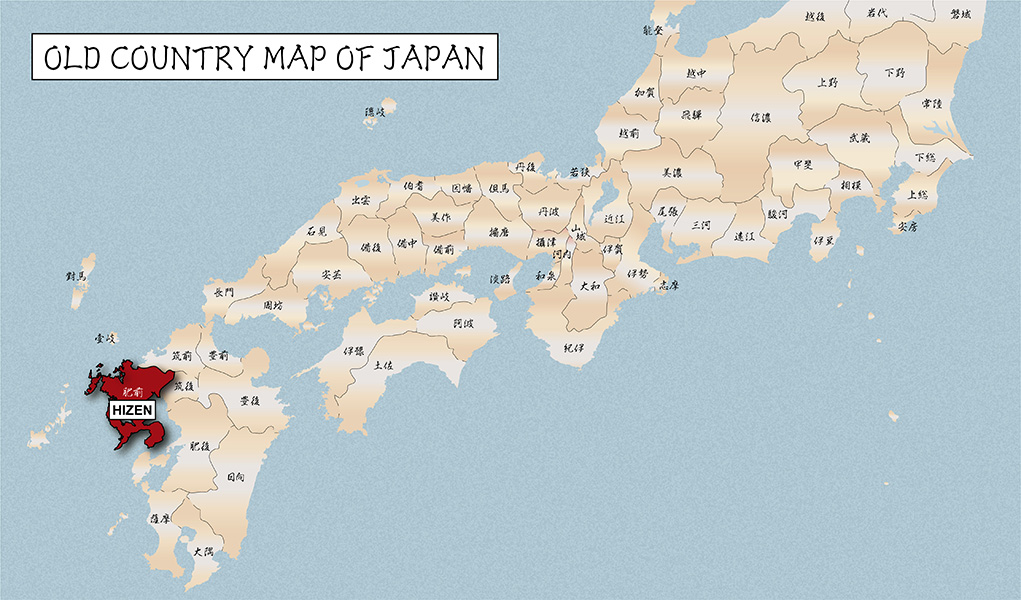
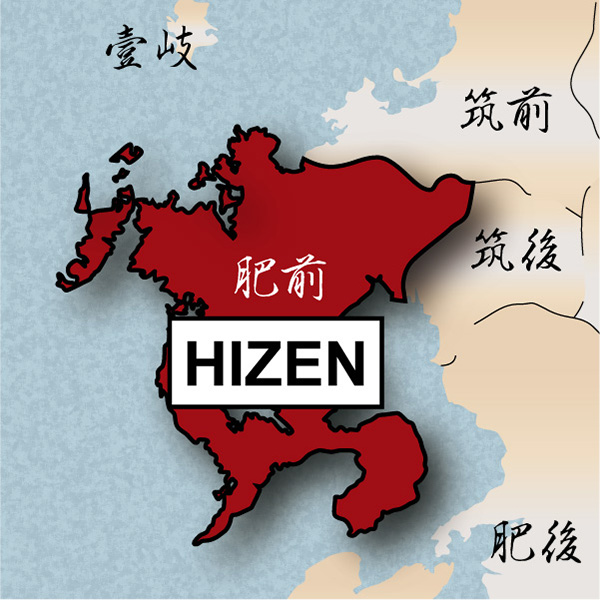
Hizen Province
Fujiwara Tadakuni and other swordsmiths in the Hizen province worked under the auspices of Nabeshima clan. The swordsmiths in Hizen province were able to produce beautiful Jigane-patterned blades, also known as Hizen To, using and mixing carbon steel made in Netherland.
You can see the beautiful Jigane, which is famous for blades made in Hizen province. Swords forged by Tadakuni are also renowned among Japanese sword collectors because of his exquisite craftsmanship and history.
The first-gen Tadayoshi (His master)
The first-gen Tadayoshi was born and raised in the Saga domain. In 1596, under the domain’s order, he went to Kyoto to learn the sword-forging technique from Umetada Myojyu(埋忠明寿), one of the greatest swordsmiths in the early Edo period. He improved his craftsmanship and returned to the Saga domain two years later (1598). The first head of the Nabeshima clan, Nabeshima Katsushige, appreciated the work of the first-gen Tadayoshi very much. Then, Katsushige appointed him as his Okakaekaji, a swordsmith who exclusively forged swords for a specific domain or clan. And Tadayoshi started to stay near Saga castle, which is the headquarter of the Nabeshima clan. And, he founded Hizen Tadayoshi school, which trained more than 100 swordsmiths during the Edo period. Tadakuni is one of them.
It is appraised as a Tokubetsu Hozon Token(特別保存刀剣) issued by NBTHK(Nihon Bijutsu Touken Hozon Kyokai:日本美術刀剣保存協会). This authentication paper was only given to authentic Japanese swords, especially well preserved and high quality with artistic value.
【 Blade】
Cutting Edge Length(Nagasa): 75.4 cm (29.7 inches)
Curvature(Sori): 2.12 cm ( 0.83 inches)


Hamon:
The crystalline structure which forms along the cutting edge of a blade as a result of the hardening process
Jimon(Jihada):
visible steel surface pattern created by folding and hammering during forging process
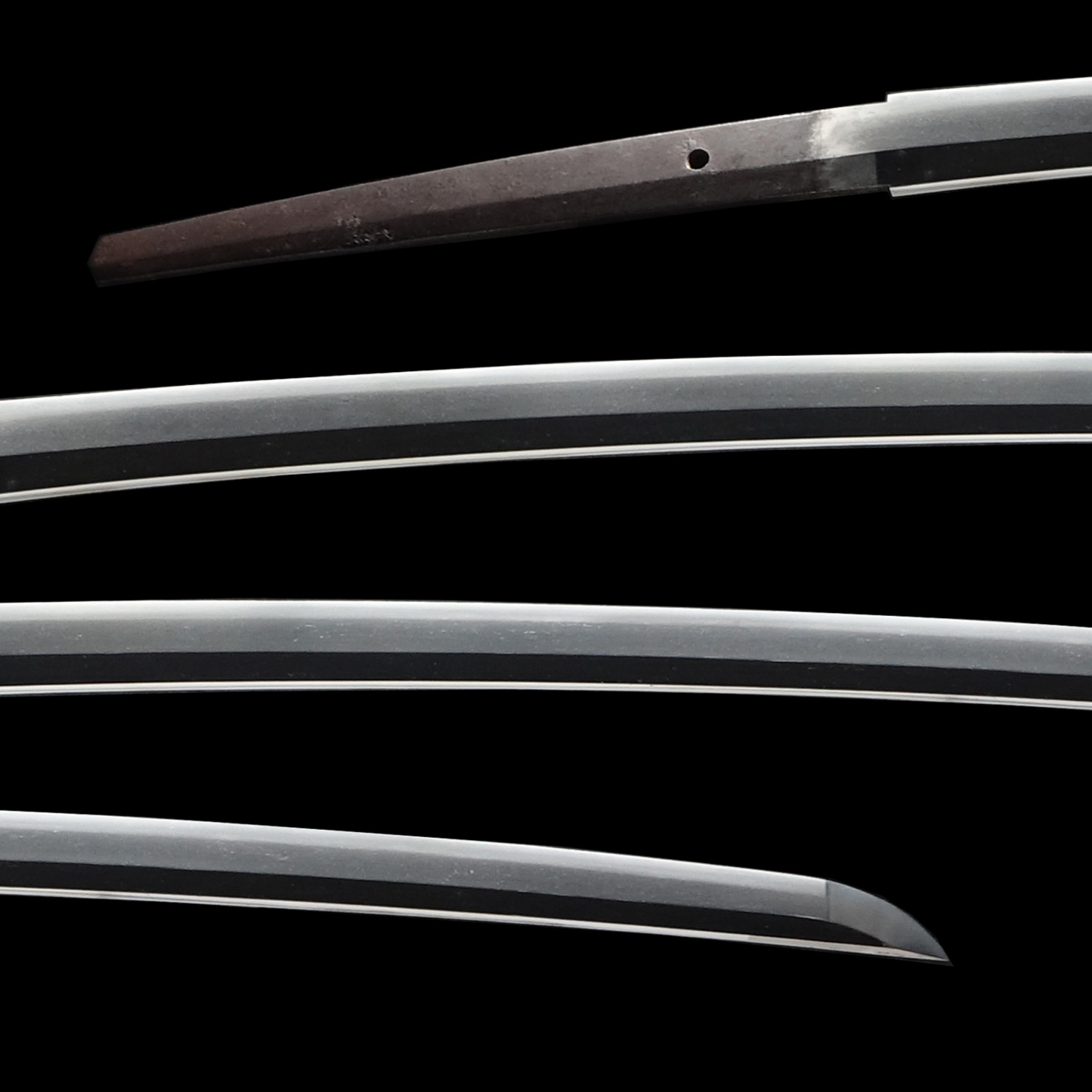
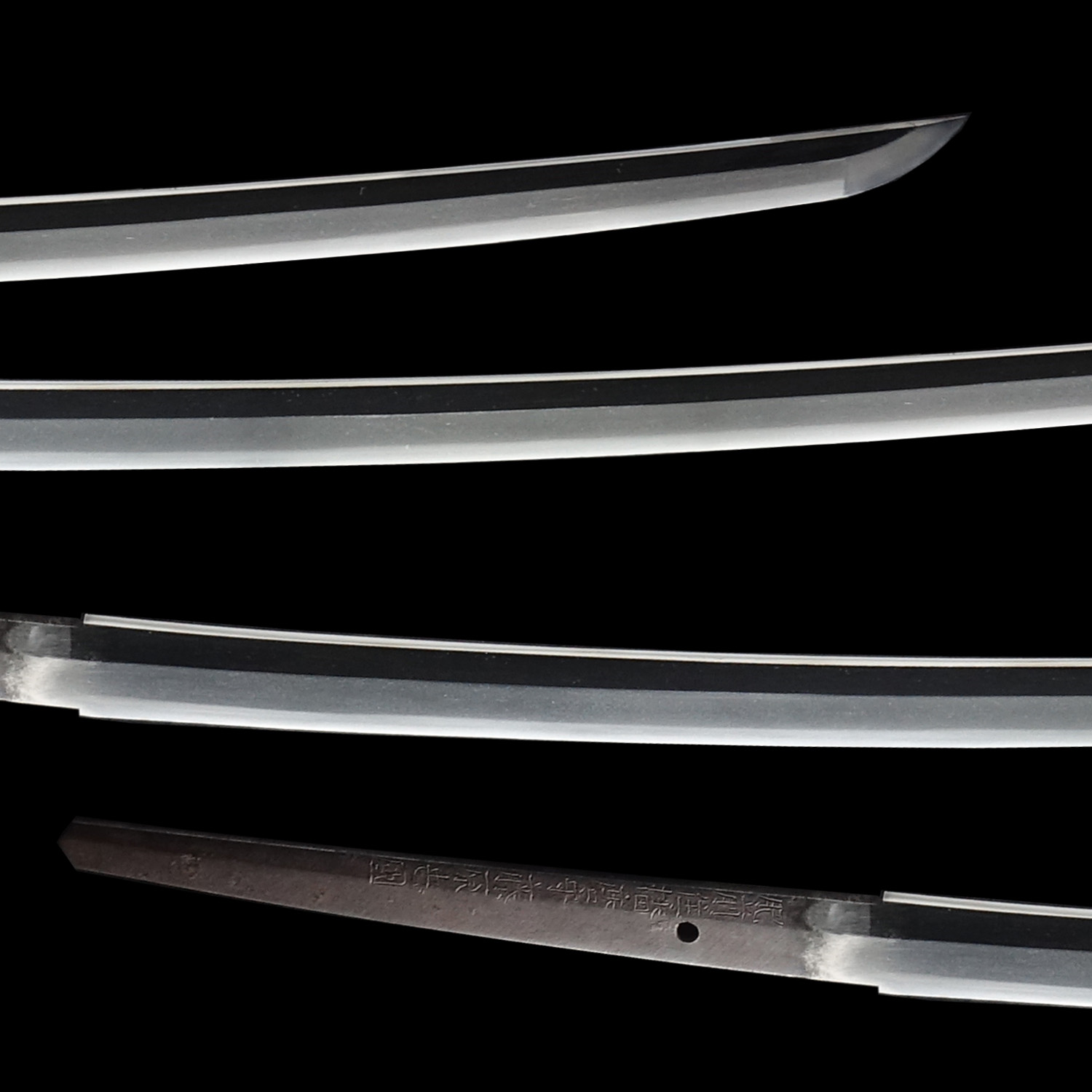
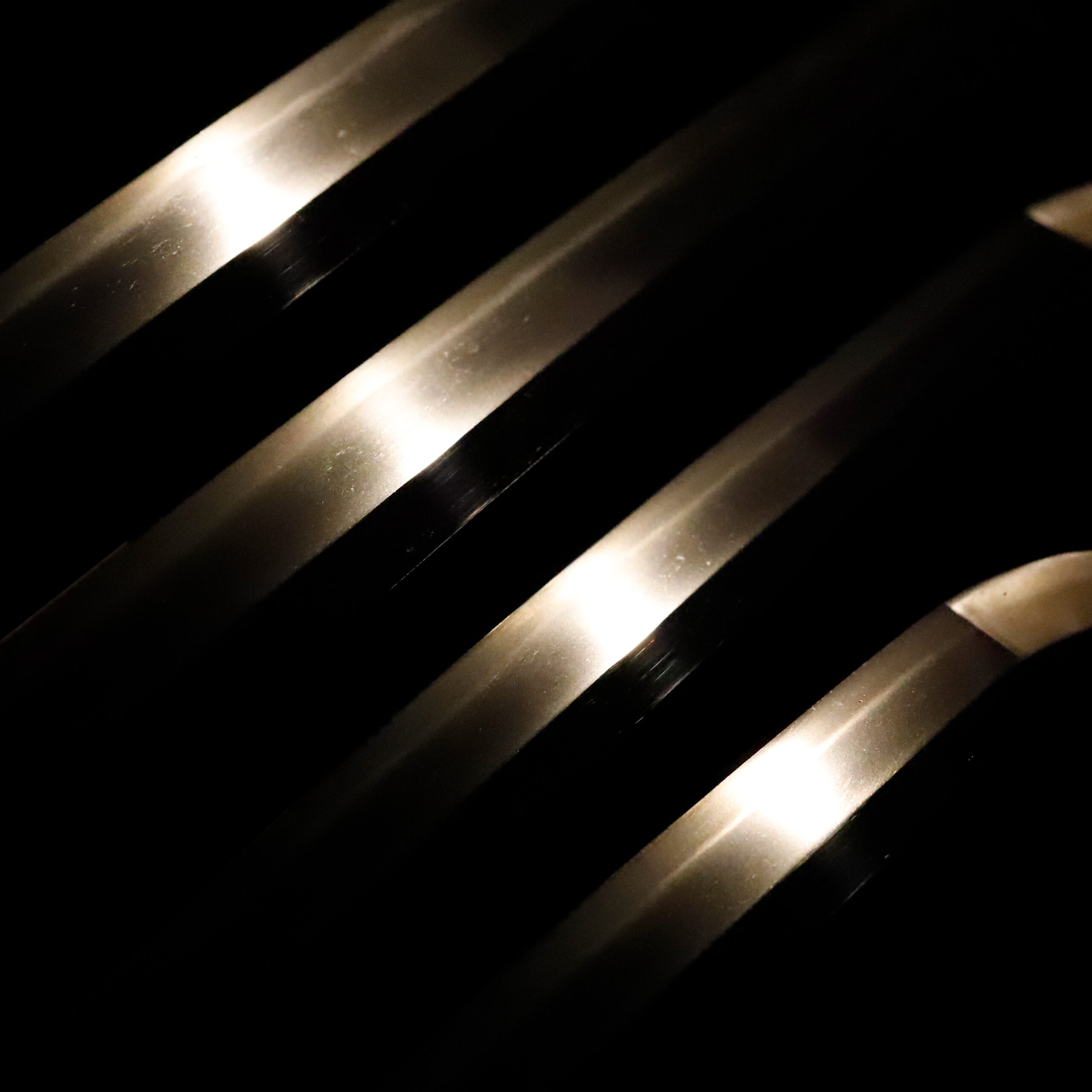

Nakago:Nakago is the tang of the Japanese sword.
Japanese swordsmiths left the black rust on the tang because it prevents red rust while the tang is in its handle. And the discoloration of the tang was created over time, and it is a great indicator for a Japanese sword specialist to estimate when the sword was forged.

Koshirae: Koshirae is the mounting of the Japanese sword. There are several parts that consist of Koshirae such as Saya(Scabbard), Tsuka(Handle), Tsuba(Handguard).

Fuchi-Kashira:A pair of matching sword fittings that cover the upper and bottom parts of its sword hilt.
This Fuchi Kashira is made from silvery color metal. The same family crest is designed on each Fuchi part and Kashira part. The family crest designed on this Fuchi Kashira is a kind of Ken Katabami (剣片喰) design called the Maru-ni Ken Katabami (丸に剣片喰). The Katabami (片喰) is a plant whose leaf has a heart mark shape. People thought this plant design represented the prosperity of descendants; therefore, many Samurai cherished this pattern. In addition, this plant was favored for its strong vitality that did not wither even when trampled as a weed. The Ken Katabami is a combination of swords and Katabami leaves. It is said that people have associated with the Samurai by incorporating the sword motif. Understandably, lots of Samurai families used the Ken Katabami pattern. It shows the relationship between this plant motif and the Samurai culture.

Tsuka and Menuki:Tsuka is the handle of the Japanese sword and Menuki is its decoration.
While we are unsure, we estimate its motif is the Fujin (風神) and the Raijin (雷神). According to Japanese myths, the Fujin controls the wind, and the Raijin controls thunder. Especially in Buddhist art, these two gods are depicted as a pair of beings. The Fujin creates a big wind from the Kazabukuro (風袋, a sac which the Fujin carries on his back) and blows it to the ground. And the Raijin rings drums on his back and causes thunder. Japan has been agriculturally advanced since ancient times. Even before Buddhism was introduced to this country from the continent, they prayed to the Fujin to calm storms or typhoons because these natural disasters caused significant damage to crops. Fujin festivals to soothe the wrath of the gods have been held in various places. This belief might have inspired this Menuki’s design.

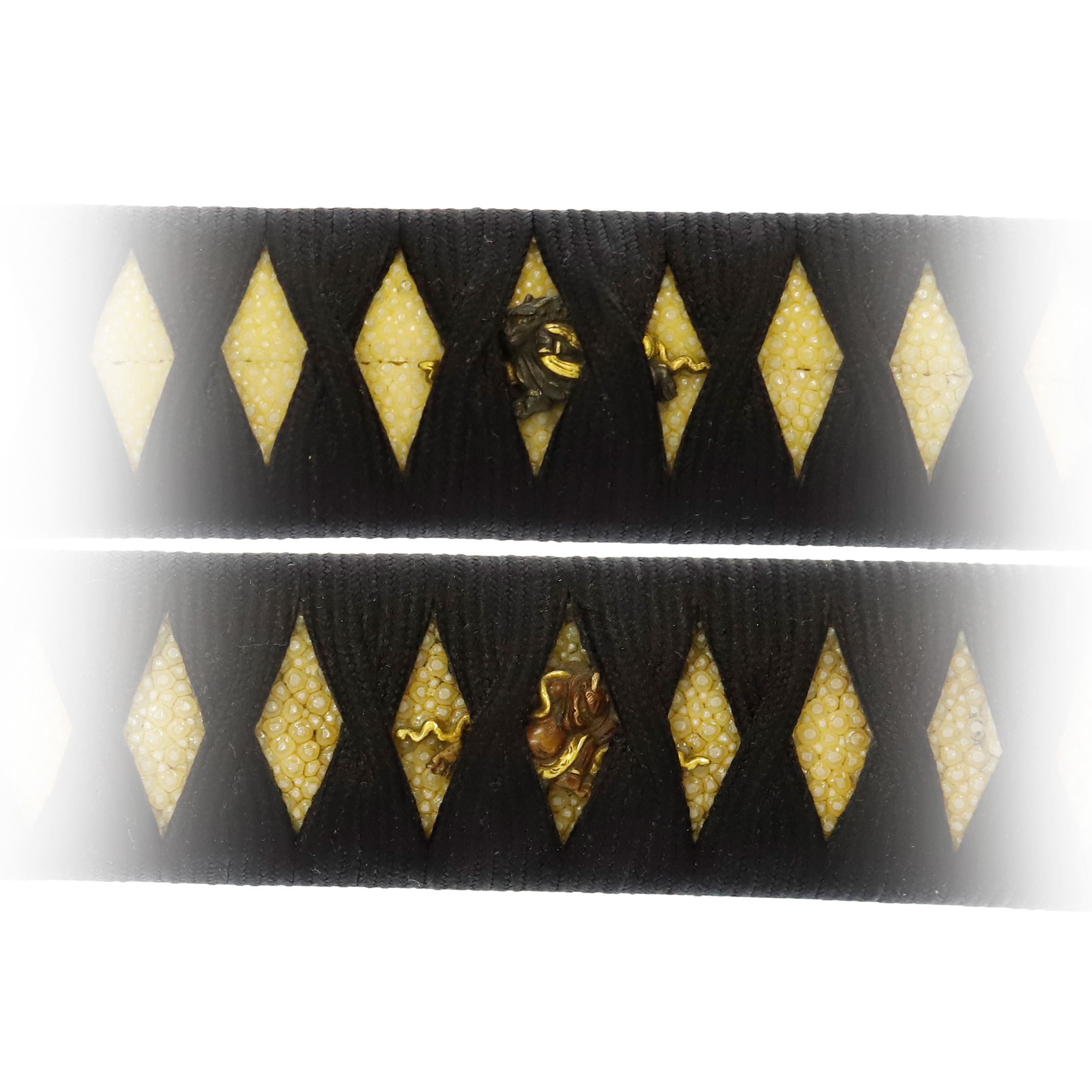
Tsuba and Habaki:Tsuba is the handguard for the Japanese Sword and Habaki is the equipment to make the blade not touch its scabbard inside. It prevents the blade from getting rusty and chipped.
Yotsu-Mokkou-shaped Tsuba made from iron. A flower-designed family crest and a kind of plant pattern is designed and inlaid with brass. This family crest’s motif is probably the Kikyou (桔梗, Japanese bellflower). Japanese bellflower is a small star-shaped flower and is one of the Aki-no Nanakusa (秋の七草, seven herbs of autumn). It is said its root has medicinal efficacy. The Kikyou pattern has often been used as a motif of Tanka (短歌, a kind of traditional Japanese poem) and pictures since the Heian period (794-1185). Its name was initially “Kichikou,” and it changed to “Kikyou” with time. It is said this flower was used for fortune-telling in the old days. This action is called Kikkyou-wo Uranau (吉凶を占う) in Japanese. The word Kikkyou (吉凶, good or bad omen) was associated with this flower’s name. “Kichikou” was compared to the word “Kichi Kou (吉更),” which means further good fortune. That is why this flower pattern is treated as a good omen design.
About the plant pattern designed on the whole of this Tsuba, this motif might be the Shida (羊歯, fern). As ferns have a high fertility rate, the Shida pattern represents children’s prosperity and success in business. Also, “羊歯” can be written as “歯朶” in Japanese. “歯” means ages, and “朶” means branches grow long; therefore, it symbolizes longevity. In Japan, people treat this plant as a good-luck omen, so it has been used for decorations of entrance in the New Year.
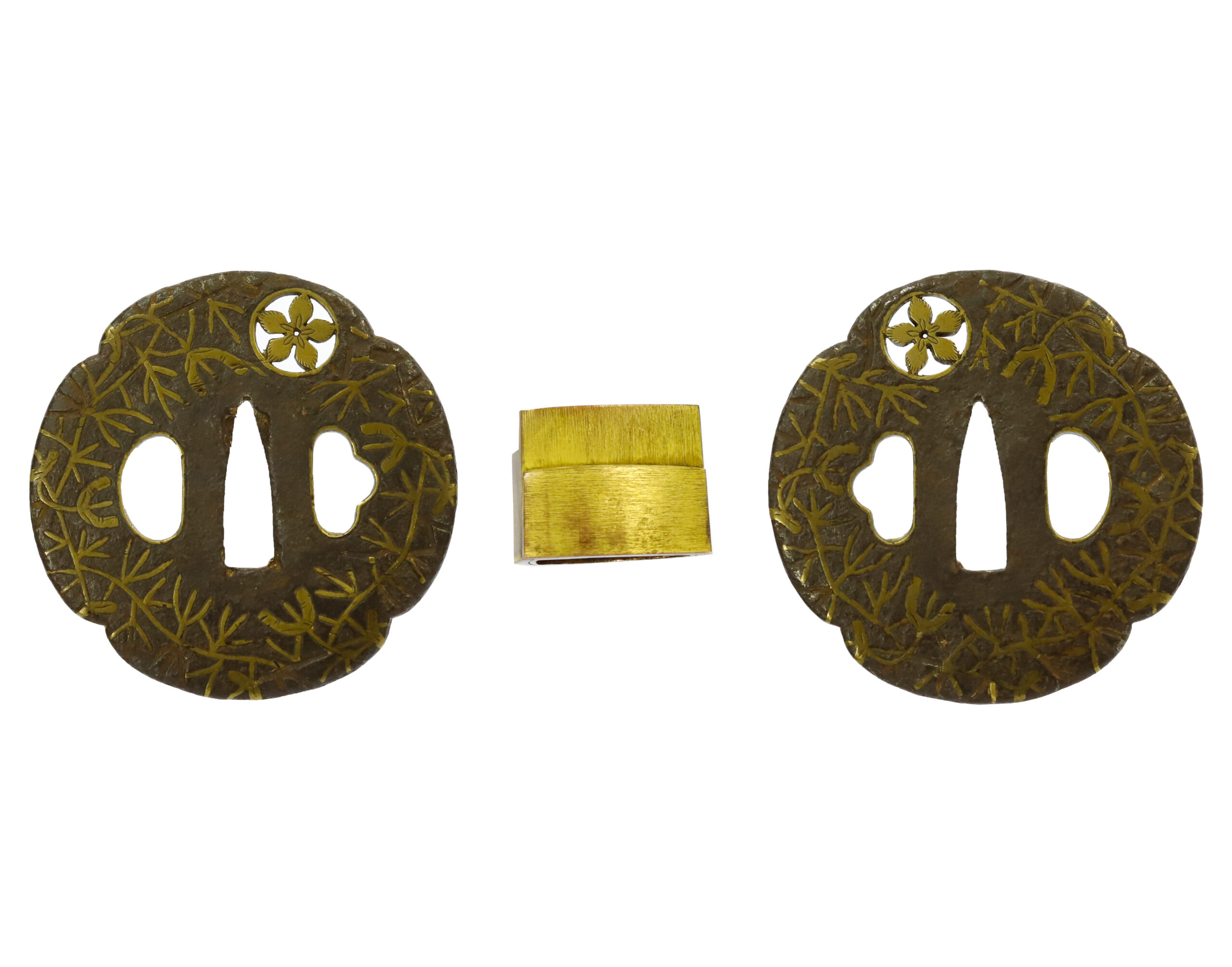
Saya: Saya is the scabbard for the Japanese sword.
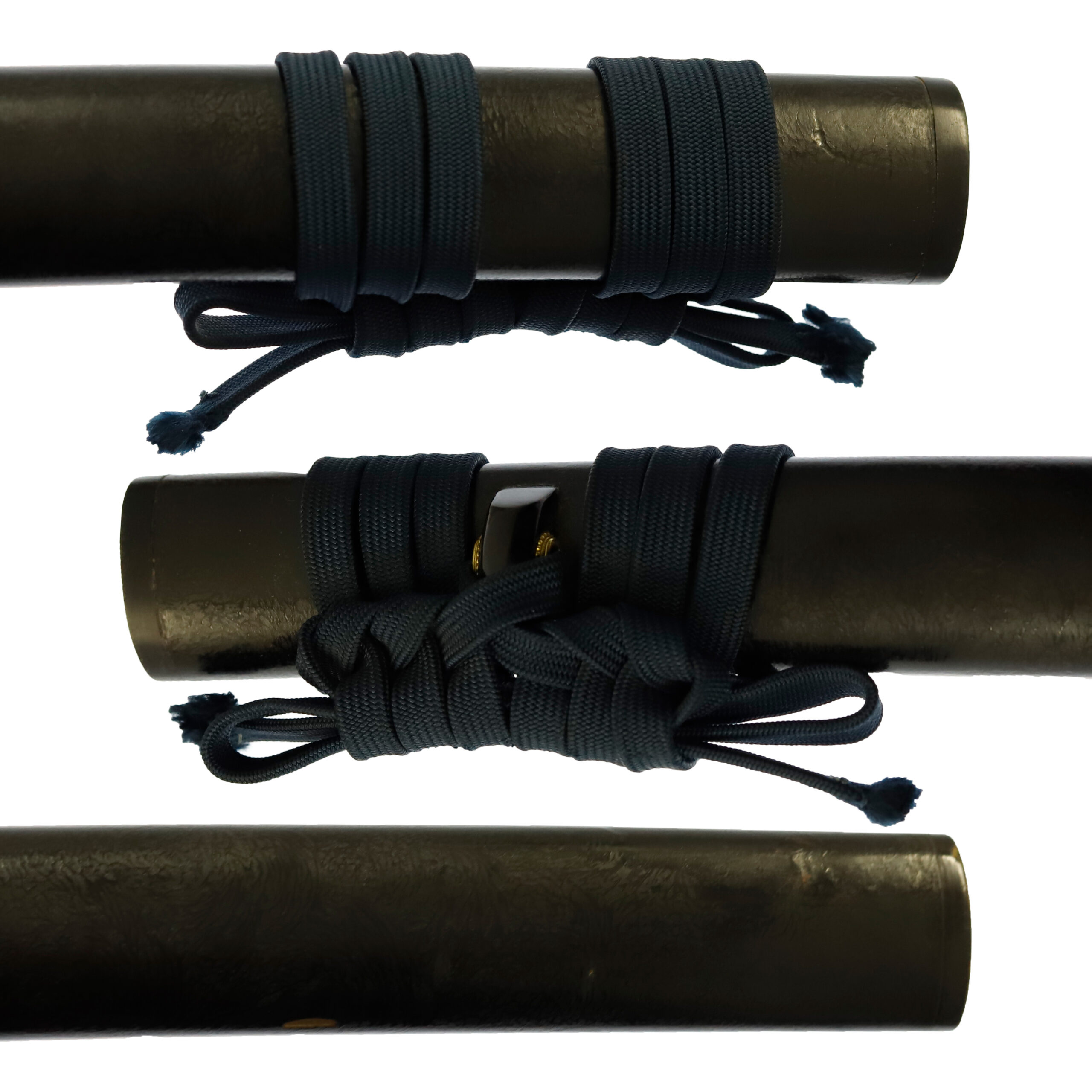
Authentication Paper:NBTHK TOKUBETSU Hozon Certificate for the blade (No. 1017735)
NBTHK, also known as Nihon Bijutsu Touken Hozon Kyokai (the Society for the Preservation of the Japan Art Sword), is one of the oldest Japanese sword appraising organizations in modern-day Japan. They authenticated the blade on June 3rd in the 4th year of Reiwa (2022). They appraised it as Tokubetsu Hozon Touken, the blade especially worth preserving for Japanese society. The purchaser will receive this original certificate as well. We can also translate what is written into English and make a PDF file for your record if you request.

Registration Number : Tokyo 8295
The Board of Education in Tokyo prefecture issued a registration paper for this sword . It is called Jyu Token Rui Torokusho(銃刀剣類登録証). Bunkacho(The Agency for Cultural Affairs) acknowledges a Japanese sword with this paper as a work of art.
The sword needs to be traditionally hand-forged and made of Tamahagane carbon steel to be registered in the system. With this paper, its owner in Japan can legally own an authentic Japanese sword. Based on this registration number, we will apply for its export permit.
This paper will need to be returned to the board of education when the sword is being shipped abroad, but you can receive a copy of it. An English translation of this registration paper is available on request.

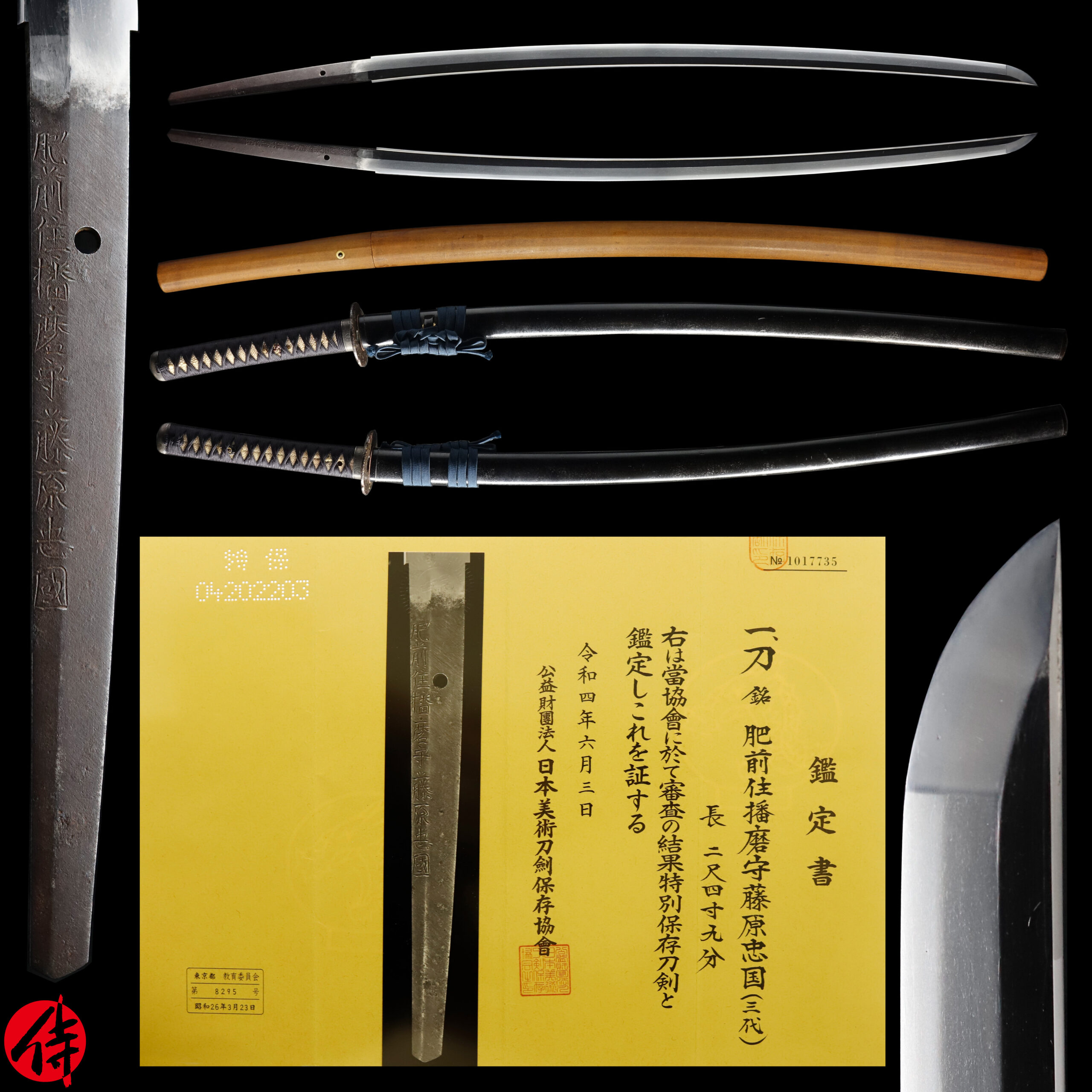
—————————————————————–
【About us】
Samurai Museum is located in Tokyo, Japan, exhibiting antique artifacts related to the Samurai history. Samurai Museum Shop is the place for those who are interested in Japanese culture and craftsmanship. We deal with antique Samurai swords/armor, traditional crafts made in Japan and so on.
【Japanese Sword& Export Process】
The Japanese swords we deal with are hand-forged edged swords made in Japan. It was made from the traditional carbon steel called TAMAHAGANE(玉鋼). Samurai Museum is familiar with the proper legal procedure for an antique/ authentic Japanese sword to be exported from Japan. We have sent more than 500 Japanese swords for the past three years (~2023) to amazing owners who appreciate its historical value.
Each Japanese sword is registered under the Agency for Cultural Affairs and the Board of Education in Japan. They issue a registration paper for each Japanese sword for its owner in Japan to legally possess it. The Japanese sword with its registration paper means it was traditionally hand-forged in Japan.
To legally export the sword from Japan to other countries, we will have to apply for its permit to the Agency for Cultural Affairs(Bunkacho) and return the original registration paper to the Board of Education. It normally takes around 2-4 weeks to receive this permit after submitting required documents. And we would like you to expect at least 1-1.5 months for your order to arrive at your given address after you ordered. For more detailed info, please click here.
It is allowed for residents in Japan to own authentic Japanese swords without a special license as long as they come with registration papers. Please feel free to contact us if you are a resident of Japan, whether temporarily or permanently. We will also assist you when you leave Japan and need to obtain an export permit. If you live in Japan, please click here before you make a purchase.
【Payment Method】
We accept payment through Stripe (Credit card), PayPal, Apple Pay or ChromePay, all of which are secure payment methods. Also, you don’t need to make an account on Stripe for the checkout. If you prefer other payment method, please contact us. After confirming your payment, we will apply for an export permit. You may either pay in JPY, USD, AUD, CAD,EUR CHF or GBP. The price is set in Japanese Yen. Prices in other currencies are automatically calculated based on the latest exchange rate.

* If the amount is above 1 million JPY, Stripe or wire transfer will be the only options for payment.
【Shipping】
We have shipped authentic Japanese swords to the USA, UK, Canada, Mexico, Germany, France, Hong Kong and Australia. If you don’t live in these countries and like to order, please contact us first before making a purchase. We offer Free International Shipping as long as we can send antique Japanese swords by EMS.
We normally ship by EMS(Express Mail Service) provided by Japan Post. We will send you a tracking number for your order as soon as we hand it to the post office. We will put 100 % insurance on the shipping document without any extra charge. Based on the total amount, there might be a duty tax or other fee for you to pay, depending on the countries. We use package cushioning to protect the item and put it in a PVC pipe, which is one of the most secure packages because of its durability.
It will normally takes 5-14 days for the item to arrive at your given address after we dispatch it. Time of delivery is estimated as accurately as possible by the carrier but does not take into account any delays beyond our control such as by inclement weather, post office holiday seasons.
* If you live in Australia and like to purchase an authentic Japanese sword, please click here to know the detail.
*Please keep in mind that due to the spread of COVID-19, there might be delays in shipping. If you like to know the detail about shipping, please feel free to ask us.

【Review】
Here is one of the reviews we received from a customer who purchased an authentic Japanese sword from us. For more reviews, please click here.
“My experience overall with the whole process was wonderful. I had many questions about the history and process to purchase these treasures. All my questions were answered very timely and complete. The staff is very knowledgeable and very well versed if any questions do arise.”
【How to make sure the condition】
Please keep in mind that what you are going to purchase is an antique item. We uploaded high resolution photos for you to check its condition thoroughly. If you like to see more photos with different angles, please feel free to contact us. We will be happy to send them to you so that you can make informed decision. It is essential for us to know that you are happy with your choice of a sword. and we are prepared to use the best of our ability to serve you.
【How To Contact Us】
Please contact us through email, Facebook Messenger or Live Chat if you have any questions. You can find each icon on the right side of the website. Please click one of them to reach us. We will reply to you within 1-2 business days.
【The Art of Nihonto (Japanese Sword)】
Samurai’s history is a profound, eloquent legacy of ancient Japanese warriors in which millions of people worldwide are being fascinated. If you like to find out the art of Nihonto, please click here.
【A Guide to Japanese Sword Maintenance】
After acquiring an genuine Japanese sword, it is also important to know how to take good care of it. Here is the special video for you. Mr. Paul Martin, Japanese sword expert, shows you how to give proper maintenance to your sword. By mastering how to clean the Japanese sword, its aesthetic beauty will last forever.
When you purchase a Japanese sword from us, you can get a Free Japanese sword maintenance kit. It comes with four tools(Choji Oil, Uchiko Whetstone Powder, Peg remover, Oil Applicator). By watching the video instruction above , you can enjoy learning how to maintain your Japanese sword while appreciating it. If you have any difficulty assembling the sword or cleaning the blade, you can feel free to contact us.


MORE ANTIQUE JAPANESE SWORD FOR SALE
SWORDS WITHOUT CERTIFICATES FOR SALE
LEARN JAPANESE SWORD TERMINOLOGY
Thank you for reading all the information on the page. If you have any difficulty choosing the right Japanese sword for you, we will be more than happy to help you find the one that speaks to you the most. Please feel free to contact us.
